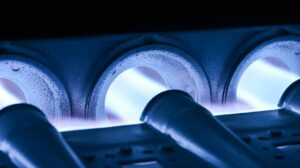 Are you using a gas-powered furnace in your household? This comes as no surprise: gas furnaces are the most popular heaters found in homes in our area, let alone around the country. They’re great for climates like ours that get more than a bit chilly in the winter!
Are you using a gas-powered furnace in your household? This comes as no surprise: gas furnaces are the most popular heaters found in homes in our area, let alone around the country. They’re great for climates like ours that get more than a bit chilly in the winter!
Gas furnaces are very cost-efficiency and a fantastic choice for the majority of homeowners. However, while gas furnaces are not inherently dangerous, there is still a present risk when you have natural gas in your home—namely, you run the risk of combustion gas leaks. The one gas you need to be concerned with here is carbon monoxide, CO.
And CO exposure can happen when you have a cracked heat exchanger in your furnace! This is a problem you should never ignore, but how do you know if you even have this problem? Read on as we dive into what a heat exchanger is, why it’s bad if it’s cracked, and what to do about it.
First, What Exactly Is a Heat Exchanger?
This is a great question! This component is the part that applies heat to the air that your blower fan sends through your ductwork and ultimately into your home. It’s a metal chamber, or series of metal chambers, that are welded together in a sort of clamshell shape. They’re arranged in rows in your gas furnace, and it’s where the hot combustion gas from the burners collect.
The gas sets off an intense heat that warms up the metal walls. This makes the outside of the heat exchanger very hot, allowing the furnace to apply heat of the combustion gas to the air without coming into contact with the air.
What Causes Cracks in Heat Exchangers?
Throughout the years, your furnace is put under a lot of strain and suffers from natural wear and tear. The heat exchangers are not immune to this wear and tear! Every time they heat up, the metal walls expand with the heat. Then as your furnace cycles off and the heat exchangers cool down, they contract. This constant movement weakens the metal, which eventually leads to corrosion, and then cracks in the heat exchanger.
As you’ve probably guessed, this is more likely to happen in an aging furnace (10–15 years old), but it’s still a risk you should keep in mind regardless of the age of your gas furnace.
What to do about a Cracked Heat Exchanger
The thing about these cracks is that they are tiny. This means you wouldn’t see them even if you opened up your furnace to try to find them yourself (please don’t do this). So, how do you know if you have a cracked heat exchanger? First off, we hope that you are scheduling routine annual maintenance for your furnace. Your heat exchangers are among the many components we check during your tune-up to ensure safe operation.
Secondly, you should have a carbon monoxide detector installed so if there is a CO leak from a cracked heat exchanger, you’ll know right away. Lastly, if you hear a clicking sound you haven’t before as your furnace cycles down, it’s a sign that you have a cracked heat exchanger: you’re hearing the crack close back up as the heat exchanger cools down and contracts.
For professional Ashburn heating repair, look no further than AllTech Services, Inc. Contact us today!

